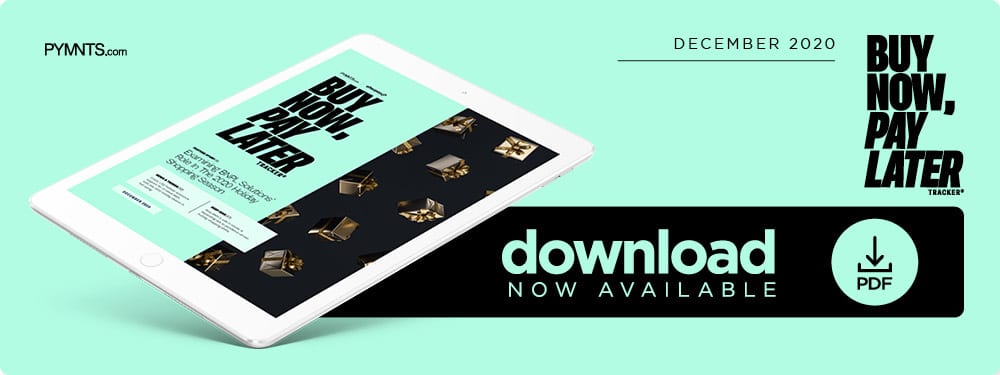Examining BNPL Solutions’ Role In The 2020 Holiday Shopping Season

Foot traffic typically skyrockets in stores during the holiday shopping season, with consumers drifting in and out of brick-and-mortar shops as they hunt for gifts.
The pandemic has changed the rules, however, and merchants have rapidly adjusted to a retail climate in which customers retain significant health concerns. The global health crisis prompted many consumers to alter their holiday habits this year, including where they shopped, what they bought and how they paid.
Keeping pace with consumers’ shopping habits has always been necessary for retailers, but adapting quickly has been even more critical during the pandemic.
“I think there are a lot of things that 2020 taught us for sure,” Camille Kress, vice president of Growth Labs for intimate clothing retailer Adore Me, said in a PYMNTS interview. “We learned resilient businesses were the ones that knew how to adapt to the new consumer needs [and] all the new commerce contexts. Those are the businesses that will still be around tomorrow and the year after that.”
Most retailers are focused on where consumers are shopping, but Kress advised they should also pay attention to how consumers are shopping. The pandemic has affected most consumers’ finances, forcing them to adjust their holiday shopping plans. This means that affected consumers are searching not only for retailers that are offering deals but also for merchants that provide flexible payment methods online and in stores. Examining their use of such payment methods — especially installment payment plans — could give retailers valuable insights as they assess the holiday shopping season and determine how to adjust their approaches moving forward.
BNPL and the Channel-Agnostic Approach
Buy now, pay later (BNPL) solutions have recently experienced rapid growth, with Black Friday and Cyber Monday data revealing that the trend has continued through the holiday season. Installment payment provider Afterpay reported that it facilitated $1 billion in U.S. sales in November, for example. This development is notable because it illustrates consumers’ growing familiarity with and trust for BNPL methods for both online and in-store sales. Eighty percent of Afterpay’s Black Friday and Cyber Monday sales were made online, but a significant share were completed at brick-and-mortar stores.
BNPL solutions’ inherent adaptability was expected to provide retailers with key advantages during the holidays, with Kress noting that consumers did not want to give up their traditional holiday shopping habits entirely. Many still planned to head to brick-and-mortar stores to shop, even if social distancing and health-focused mandates made the experience a little different from previous years. She noted that numerous shoppers who headed to Adore Me’s brick-and-mortar stores before the pandemic returned to physical locations once health and safety guidelines allowed such behavior.
“What we are seeing is the customers who come to shop in our stores, they really love everything that the store has to offer, which is the sales associates, … the fitting room … [and] guidance,” Kress noted. “So, I think, until we figure out a way to have this type of guidance [and] expertise in the online realm, I think the store still brings something to a type of customer.”
She added that while Adore Me does not yet offer BNPL solutions, the payment method is on its roadmap for the future because it is important to provide flexible payments as consumers’ financial concerns shift. The company has a home try-on product that works as a kind of BNPL-lite, Kress explained, allowing customers to have items delivered to their homes and experience some of the benefits of physical shopping features without outright paying for goods.
Finding channel-agnostic payment methods that bridge the physical-to-eCommerce shopping gap and enable savings could give retailers a competitive edge as it becomes clear that offering consumers’ preferred payment methods is integral to keeping their loyalty.
“If you don’t offer a payment method the customer uses when they get to the checkout, there’s nothing else you can do to convert that customer,” Cooper Watts, director of IT and eCommerce for omnichannel luxury retailer OAK + FORT, said in a PYMNTS interview. “So, widening the options we accept in every way possible, whether that’s buy now, pay later or some other form of digital — like bitcoin or some sort of Visa service or Apple Pay — is very important.”
PYMNTS research also indicates that BNPL is quickly becoming the preferred payment method for more consumers. The study found that 48 percent of consumers using installment payment methods to make purchases both online and in stores would not spend with merchants that do not offer such options. It is therefore imperative that retailers examine how BNPL plans powered consumers’ holiday spending and how they could continue to boost spending in 2021.
Omnichannel Shopping and the Millennial Factor
Keeping pace with consumers’ online and in-store payment requests and establishing BNPL solutions’ role in addressing them are essential for retailers that are competing across multiple channels.
BNPL is proving especially popular among younger consumers, many of whom have less money saved than older generations. These younger shoppers will represent a larger portion of consumer spend in the near future. PYMNTS data found that both bridge millennials and younger millennials are using BNPL methods at almost twice the rate of older generations. Twenty-seven percent of millennials used installment payments to make their most recent purchases online, for example, and just 13 percent of nonmillennials said the same.
Several factors show that BNPL methods are playing a more prominent role in retail and suggest they will become even more popular over the next several years. Retailers must therefore examine how consumers tapped installment payment plans for 2020 holiday purchases as they make future plans.

